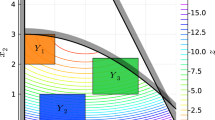Abstract
The mathematical notation commonly applied for the formulation of mathematical programming models is extended to include hierarchical structures. The proposed notation is related to hierarchical set concepts in the languages UIMP, AMPL, and LPL. With the proposed notation it is possible to aggregate and disaggregate over hierarchical structures. In addition, views are introduced to permit the use of hierarchical substructures and to create new hierarchies out of existing ones. The proposed notation for hierarchical sets and views is illustrated by applying it to the representation and estimation of social accounting matrices (SAMs).
Access this article
We’re sorry, something doesn't seem to be working properly.
Please try refreshing the page. If that doesn't work, please contact support so we can address the problem.
Similar content being viewed by others
References
J.M. Anthonisse, “An input system for linear programming problems,” Statistica Neerlandica 24 (1970), 71–81.
J.J. Bisschop and C.A.C. Kuip, “Compound sets in mathematical programming modeling languages,” Memorandum 834, University of Twente, Enschede, Netherlands, 1989.
J.J. Bisschop and A. Meeraus, “On the development of a general algebraic modeling system in a strategic planning environment,” Mathematical Programming Study 20 (1982), 1–29.
G.H. Bradley and R.D. ClemenceJr, “A type calculus for executable modeling languages,” IMA J. of Math. in Management 1 (1987), 277–291.
R.P. Byron, “The estimation of large social account matrices,” J. of the Royal Statistical Society, Series A 141 (1978), 359–367.
V. Chvátal, Linear Programming, Freeman: New York, NY, 1983.
A. Drud, W. Grais, and G. Pyatt, “The transaction value approach: A systematic method of defining economywide models based on social accounting matrices,” in Dynamic Modelling and Control of National Economies, T. Basar and L.F. Pau, eds., Pergamon Press: New York, NY, 1983, 241–248.
A. Drud and D. Kendrick, Hercules, A System For Large Economywide Models, third ed., ARKI Consulting and Development A/S: Bagsvaerd, Denmark, 1990.
E.F.D. Ellison and G. Mitra, “UIMP: User interface for mathematical programming,” ACM Trans. on Math. Software, 8 (1982), 229–255.
R. Fourer, “Modeling languages versus matrix generators for linear programming,” ACM Trans. on Math. Software, 9 (1983), 143–183.
R. Fourer, D.M. Gay, and B.W. Kernighan, “A modeling language for mathematical programming,” Mgmt. Sci. 36 (1990), 519–554.
A.M. Geoffrion, “An introduction to structured modeling,” Mgmt. Sci. 33 (1987), 547–588.
A.M. Geoffrion, “The formal aspects of structured modeling,” Operations Res. 37(1) (1989), 30–51.
A.M. Geoffrion, “Indexing in modeling languages for mathematical programming,” Working paper 371, Western Management Science Institute, University of California, Los Angeles, CA, 1989.
H.J. Greenberg, “A functional description of ANALYZE: A computer-assisted analysis system for linear programming models,” ACM Trans. on Math. Software, 9 (1983), 18–56.
H.J. Greenberg, “A natural language discourse model to explain linear programming models and solutions,” Decision Support Systems, 3 (1987), 333–342.
T. Hürlimann and J. Kohlas, “LPL: A structured language for linear programming modeling,” OR Spektrum, 10, (1988), 55–63.
C.V. Jones, “An introduction to graph-based modeling systems, Part I: Overview.” ORSA J. on Computing, 2(2) (1990), 136–151.
C.A.C. Kuip, “Algebraic languages for mathematical programming,” Memorandum 902, Faculty of Applied Mathematics, University of Twente, Enschede, The Netherlands, 1990 (to be published in European J. of Operational Res.).
C. Lucas and G. Mitra, “Computer-assisted mathematical programming (modeling) system: CAMPS,” The Computer J. 31 (1988), 364–375.
A. Meeraus, “An algebraic approach to modeling,” J. of Economic Dynamics and Control 5 (1983), 81–108.
G. Pyatt and J.I. Round, eds., Social Accounting Matrices, a Basis for Planning, The World Bank: Washington, D.C. 1985.
I. Sagi, “Computer-aided modeling and planning (CAMP),” ACM Trans. on Math. Software 12 (1986), 225–248.
D. Steiger and R. Sharda, “Modeling languages for personal computers: A comparison,” Presented at the APMOD91, London and to be published in the Annals of Operations Res..
R. Stone, “The development of economic data systems,” in Social Accounting for Development Planning with Special Reference to Sri Lanka, G. Pyatt and A.R. Roe, eds., Cambridge University Press, Cambridge, England, 1977, xvi-xxx.
H.P. Williams, Model building in mathematical programming, 3rd Ed., Wiley: Chichester, England, 1990.
Author information
Authors and Affiliations
Rights and permissions
About this article
Cite this article
Bisschop, J.J., Kuip, C.A.C. Hierarchical sets in mathematical programming modeling languages. Comput Optim Applic 1, 415–438 (1993). https://doi.org/10.1007/BF00248765
Received:
Issue Date:
DOI: https://doi.org/10.1007/BF00248765




